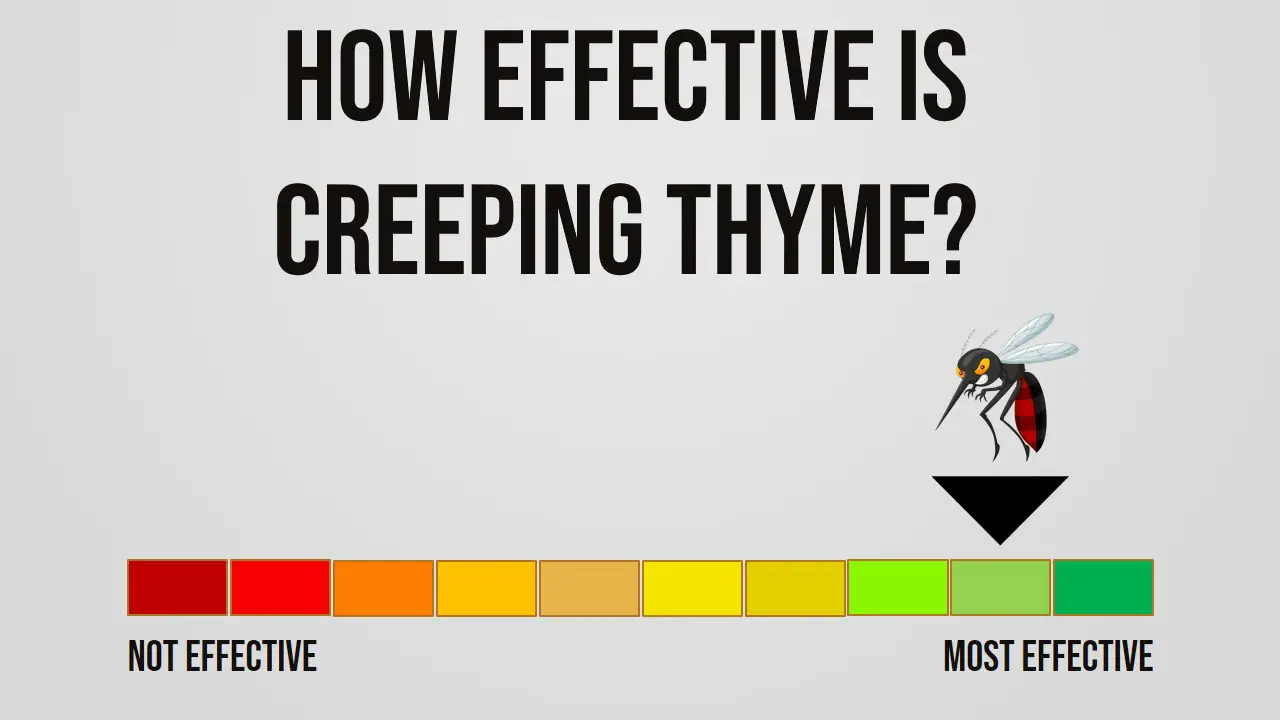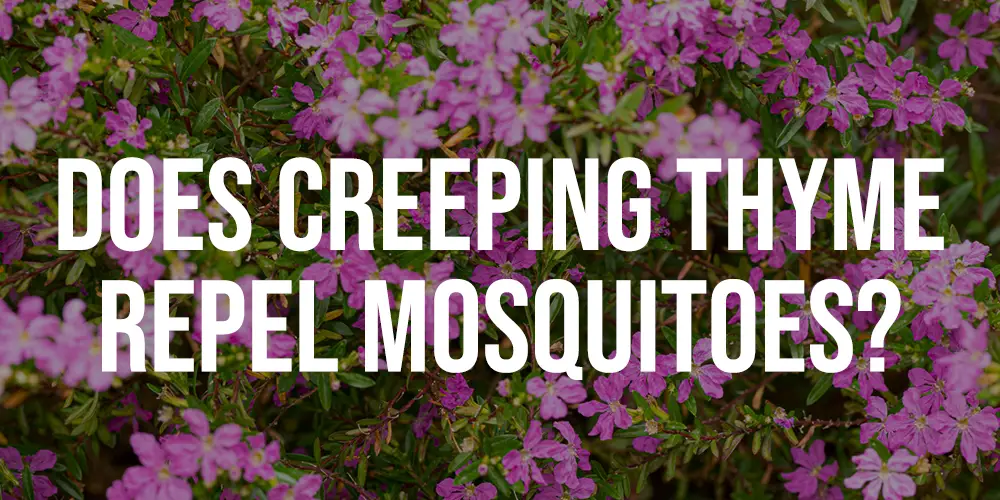Yes, creeping thyme does repel mosquitoes. The plant produces natural oil that is effective in repelling these pests. Mosquitoes are not attracted to the scent of this oil, which helps to keep them away from areas where it is present. Additionally, the plant’s leaves can also be crushed and used as a natural insecticide. If you are looking for an all-natural way to repel mosquitoes, then growing creeping thyme in your garden may be a good option.
Creeping thyme is also a popular herb that is used in cooking and healing. It has a mild, lemony flavor that makes it ideal for use in soups and sauces. Additionally, the plant has been used in traditional medicine for hundreds of years. It is often taken as a tea to help treat coughs and colds, while its essential oils are used topically to soothe skin irritations.

Navigation
How to Grow Creeping Thyme
If you are interested in growing creeping thyme, then you will need to choose a planting location that gets full sun. The plant grows best in well-drained soil that is rich in organic matter. Additionally, it is important to keep the soil moist but not wet. When watering the plant, be sure to use a drip irrigation system or water it at the base of the plant to avoid getting the leaves wet.
Once you have chosen a suitable location, you can purchase creeping thyme seeds or plants from a nursery or online retailer. When planting the seeds, be sure to plant them in an area that gets full sun and has well-drained soil. Once the plants have germinated, you will need to thin them out so that they are about eight inches apart.
To help the plant grow, you will need to fertilize it once every two weeks using a balanced fertilizer. Additionally, you will need to prune the plant regularly to encourage new growth. When pruning, be sure to cut back any woody stems so that new shoots can emerge.
If you live in an area where there is a risk of frost, then you will need to take steps to protect your plants. One way to do this is to mulch them with straw or leaves. You can also cover the plants with a frost blanket or tarp.
Creeping thyme is a hardy plant that can tolerate most growing conditions. However, it is important to provide it with the proper care in order to ensure that it thrives. By following these tips, you can enjoy the many benefits that this versatile plant has to offer.
Is Creeping Thyme Better than Citronella for Mosquitoes
Creeping thyme is a species of flowering plant in the mint family, Lamiaceae. It is native to Europe, Asia, and Africa, but it has been introduced to North America and Australia. The plant is common in gardens and as a groundcover. It is also used as an herb or spice.
The leaves and flowers of creeping thyme contain compounds that give off a strong scent. This is believed to keep mosquitoes away, and it is often used in natural insect repellents. However, there is little scientific research on the effectiveness of this plant as a mosquito repellent.
Some people have reported success using creeping thyme to repel mosquitoes. But it may not be as effective as citronella. If you are looking for an alternative to these products, try growing creeping thyme around your home. You can also experiment with using the leaves and flowers in natural insect repellent recipes.
Difference Between Creeping Thyme and Red Thyme
Creeping thyme and red thyme are two popular types of thyme that are often used in cooking. Though they share many similarities, there are also some key differences between these two herbs.
For one, creeping thyme is a low-growing plant that spreads outwards as it grows, while red thyme is a taller plant with a more upright growth habit. Additionally, creeping thyme has smaller, more delicate leaves than red thyme, and its flowers are typically a pale pink or lavender color. Red thyme, on the other hand, has dark green leaves and bright red flowers.
When it comes to flavor, both creeping thyme and red thyme have a strong, pungent taste that is often used to flavor meats and vegetables. However, creeping thyme is generally considered to have a milder flavor than red thyme.
So, when deciding which herb to use in your cooking, it really comes down to personal preference. If you want a more subtle flavor, go with creeping thyme, while if you want a more robust flavor, red thyme is the better choice.
In summary, there are several key differences between creeping thyme and red thyme. Creeping thyme has low-growing, spreading stems and smaller, more delicate leaves than red thyme. Additionally, its flowers are typically pale pink or lavender in color. Red thyme, on the other hand, has dark green leaves and bright red flowers. Finally, while both herbs have a strong flavor, creeping thyme is generally considered to be milder-tasting than red thyme.
Red Creeping Thyme Mosquito Repellent
Red creeping thyme is a popular mosquito repellent. Its leaves and flowers emit a strong scent that mosquitoes find unpleasant. You can grow red creeping thyme in your garden or purchase it as a plant or dried herb. To use it as a mosquito repellent, simply crush the leaves and rub them on your skin. You can also make a mosquito repellent spray by adding a few drops of essential oil to water. Use this repellent whenever you are outdoors to protect yourself from mosquito bites.
Creeping Lemon Thyme Mosquitoes
Lemon thyme is an effective mosquito repellent and can be used in a variety of ways. You can plant it in your garden or yard, or use the essential oil for topical application or diffusing.
When diffusing lemon thyme oil, make sure to keep the doors and windows closed so that mosquitoes cannot enter. Lemon thyme oil is also an effective mosquito repellent when used topically. You can rub the essential oil onto your skin, or mix it with a carrier oil like coconut or jojoba and apply to your skin that way.
Whether you use lemon thyme in your garden or as a topical treatment, this versatile herb is a great way to keep mosquitoes at bay. Give it a try and see how well it works for you.
What are all the different types of thyme?
There are many different types of thyme, including:
- Common thyme (Thymus vulgaris)
- Garden thyme (Thymus vulgaris)
- Lemon thyme (Thymus citriodorus)
- Wild thyme (Thymus serpyllum)
- Oregano thyme (Thymus mastichina)
- Red thyme (Thymus praecox subsp. arcticus)
- Caraway thyme (Thymus herba barona)
- Culinary thyme (Thymus x citriodorus ‘Citriodorum’)
Not all of these types of thyme are used in cooking, but many of them are. Thyme is a very versatile herb that can be used in many different dishes. It has a strong, pungent flavor that goes well with meats, vegetables, and soups. Thyme is also used to make teas and oils, as well as in aromatherapy.
DIY Creeping Thyme Mosquito Repellent
If you are tired of using insect repellents that contain dangerous chemicals, then give this DIY creeping thyme mosquito repellent a try. It is made with all-natural ingredients and it works great to keep the annoying pests away without harming your family.
Ingredients:
- Creeping thyme essential oil – 1/4 teaspoon
- Cinnamon leaf essential oil – 1/4 teaspoon
- Witch hazel – 1 cup
Instructions:
1. Pour the witch hazel and the oils into a spray bottle and shake it to combine the ingredients well. You should use glass bottles that don’t react with the other ingredients.
2. Spray the mixture around your home, on your patio or deck, and anywhere else you want to keep mosquitoes away. Reapply it as needed, especially after it rains.
The essential oils in this recipe will help to repel mosquitoes while the witch hazel acts as a natural insecticide. This DIY repellent is safe to use around kids and pets.
Note: If you don’t want to use essential oils then you can replace them with dried thyme leaves and vanilla extract. Use 2 tablespoons of each instead of the oils.

